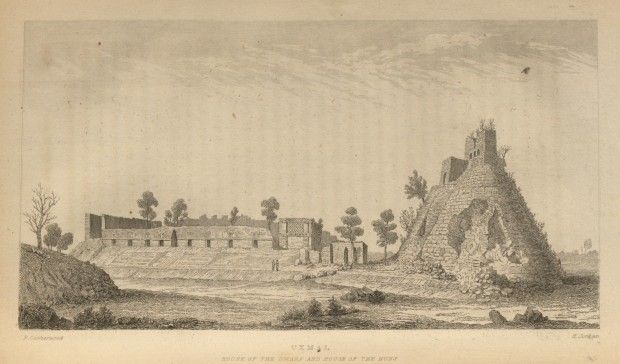“The great field in front of the Casa del Gobernador was planted with corn, and on the way we learned a fact which may be interesting to agriculturists in the neighbourhood of those numerous cities throughout our country which, being of premature growth, are destined to become ruins. The debris of ruined cities fertilize and enrich land. Don Simon [de Peon] told us that the ground about Uxmal was excellent for milpas or corn-fields. He had never had a better crop of maize than that of the last year; indeed, it was so good that he had planted a part of the same land a second time, which is a thing unprecedented under their system of agriculture; and Don Simon had another practical view of the value of these ruins, which would have done for the meridian of our own city [New York City]. Pointing to the great buildings, he said that if he had Uxmal on the banks of the Mississippi, it would be an immense fortune, for there was stone enough to pave every street in New Orleans, without sending to the North for it, as it was necessary to do; but, not to be outdone in sensible views of things, we suggested that if he had it on the banks of the Mississippi, easy of access, preserved from the rank vegetation which is now hurrying it to destruction, it would stand like Herculaneum and Pompeii, a place of pilgrimage for the curious; and that it would be a much better operation to put a fence around it and charge for admission, than to sell the stone for paving streets.” — John Lloyd Stephens, Incidents of Travel in Yucatan, p. 232 – 233
- Stephens is warning his readers that U.S. cities will one day be ruins…why?
- Think about Don Simon’s idea for paving the streets of New Orleans with the stones of Uxmal against the stuff on spolia we discussed at Izamal yesterday…
- Isn’t it creepy how prescient Stephens and Catherwood’s touristic plans for ancient ruins are?
- We’ve observed that archaeological sites are also sites of “pilgrimage” for tourists, and even drawn comparisons between the most famous site in the Yucatán (Chichén Itzá) and a theme park. But how are archaeological sites different from purely touristic sites, and how do the sites negotiate the tension between tourism and historical preservation? What would Uxmal look like if the archeologists had complete control? What if private landowners/property developers had complete control?
- After the trip to Uxmal, take a look back at the photos you took at Chichén Itzá, Kinich Kak Moo, and now Uxmal. How are they different? What did you focus on at each site, and how did the architectural and human context of each site condition your photographs?
